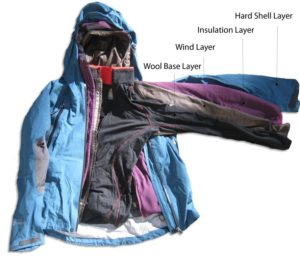Nordic Clothing Basics
The goal is to remain comfortable (not cold, not hot) in a winter environment while exercising and while resting.
- Thermal insulation – preserving body warmth
- Moisture control – letting perspiration escape while keeping melting snow and rain out.
- Wind barrier – protecting against wind chill
Clothing Material
- Use Synthetics or Wool – especially against the skin, to wick away persperation. Wool insulates even when wet
- NO COTTON – especially against the skin or as a mid (insulation) layer. Cotton promotes evaporative cooling – not a good idea in a winter environment
Core Protection – use a layer system for upper and lower body protection.
- Base layer – insulate and transport moisture away from skin
- Middle layer – thermal insulation
- Outer layer – for wind and moisture barrier(s)
Extremity Protection for head, hands and feet:
- Cap – Wool or synthetic with thermal barrier protection. Since heat loss is greatest from the head, you can put-on or take-off the cap as a primary way to control body heat.
- Gloves – light X-C ski gloves (not insulated alpine gloves). Mittens will keep fingers warmer. Carry extra gloves.
- Wool or synthetic socks – use a thin liner sock under a medium weight outer sock
- Gaiters for deep snow
Eye Protection: Use dark wrap-around sunglasses, NOT ski goggles, to protect your eyes against the harsh light reflected off of the snow. If you don’t bring them, you will squint a lot and may damage your eyes. Downhill (Alpine) ski goggles are usually not appropriate to XC skiing because Nordic skiing is a higher energy activity and goggles are likely to fog. In fact, you may even want to use anti-fog solution on your sunglasses.
Use a Pack to carry the gear you may need. Some considerations:
- Low center of gravity (match body’s center of gravity)
- Stable support – pack does not swing
- Supports weight from hips not shoulders
- Especially important for back country skiing
Gear you may need:
- Extra clothes – to replace wet clothes or to cover up when needed, think layer system!
- Water and food – energy snacks and meals, hydrate before you feel thirsty
- The 10 Essentials and other survival equipment – see The Ten Essentials

